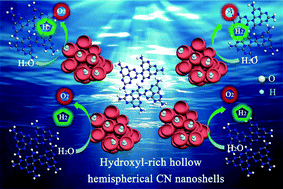Strategy to boost catalytic activity of polymeric carbon nitride: synergistic effect of controllable in situ surface engineering and morphology†
Abstract
Polymeric carbon nitride (CN) is a promising metal-free catalyst plagued by a low intrinsic activity. Herein, a novel strategy based on controllable in situ surface engineering and morphology was developed to synergistically boost the catalytic activity of CN by tuning the hydroxyl groups on its surface and constructing a unique nanostructure. The controllable introduction of hydroxyl groups on CN nanoshells, prepared by the thermal condensation of oxygen-containing supramolecular precursors formed in water, led to spatial separation of the HOMO and LUMO, and effective exciton dissociation, as verified by experiments and ab initio calculations. Furthermore, the hollow hemispherical nanoshell endowed more exposed active sites, optimal mass transport, and dynamic modulations. The optimized hollow hemispherical CN nanoshells exhibited remarkable catalytic activity, with a photoelectrocatalytic OER overpotential of about 330 mV at a current density of 10 mA cm−2, outperforming state-of-the-art precious-metal catalyst IrO2. High activity for the visible-light photocatalytic HER and pollutant degradation were also observed. This study proposes that, through rational surface group modification, a polymer material with high catalytic activity can be practically realized, which is promising for the design of efficient metal-free catalysts.



 Please wait while we load your content...
Please wait while we load your content...